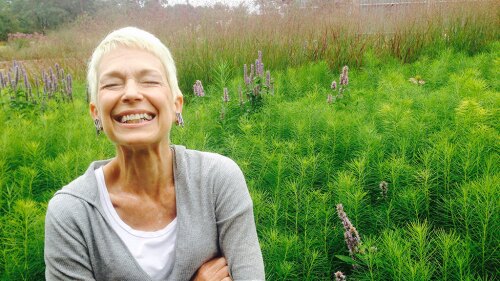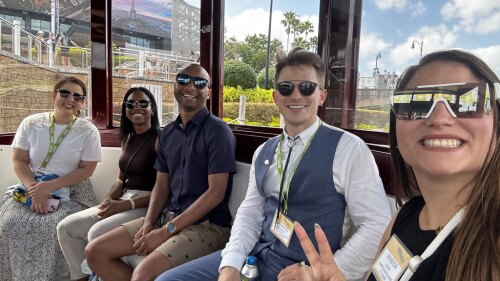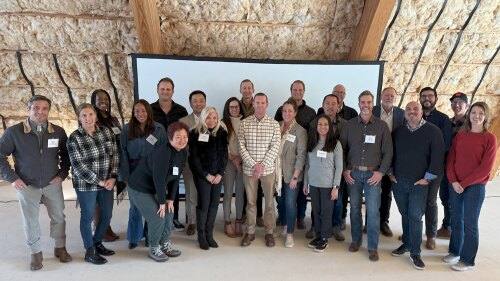Bringing promising graduate students into ULI product councils is part of developer Steve Chamberlin’s grand ambition to boost education at all levels.
Allie Stein’s first ambition in life was to become an attorney. After earning a bachelor’s degree from Trinity College in Hartford, Connecticut, she landed a job as an analyst at the U.S. Department of Justice. But it did not take long for her to realize that she wanted something different from life—something that real estate development could provide.
“It actually comes back to my upbringing in Baltimore, where I spent a lot of time in middle and high school volunteering with Habitat for Humanity,” Stein explains. “Seeing the dynamics of the city where I grew up—the socioeconomic and racial disparities—stuck with me.”
She decided to get a graduate degree in urban planning at the University of California, Berkeley, which she chose because it was one of the few programs that had a real estate concentration. Through a graduate student club at Berkeley, Stein learned about the Urban Land Institute and its work in helping solve urban problems.
“I quickly realized the benefit of being involved in an organization like ULI,” she recalls. One problem: as a student, she could not afford the cost of full membership. Then she found out about the Institute’s Chamberlin Graduate Student Fellowship.
Started by Northern California developer Steve Chamberlin, the two-year program helps graduate students from UC Berkeley, Cornell University, and the University of Pennsylvania by giving them a two-year ULI full membership, paying their way to attend the ULI Fall Meeting and Spring Meeting, providing travel and lodging allowances, and giving them a coveted position on a ULI product council.
The Institute’s product councils are groups of ULI members—often senior figures in the industry—who hold meetings to discuss and debate important issues in a confidential setting, which allows them to share detailed information about business deals and describe their own experiences openly.
As explained on ULI’s website, council members “play a critical role in building communities; developing and redeveloping neighborhoods; envisioning and re-creating business districts; planning and implementing industrial parks; bringing residential, retirement, and recreational spaces to life; and designing mixed-use facilities that are a part of our nation’s sustainable urban and suburban environments.”
For the graduate Chamberlin Fellows, the program is a chance to interact with and learn from executive-level industry leaders in candid sessions on important issues.
Since 2001, the year that the Chamberlin Fellowship was launched, 143 fellows have participated, many of whom remain involved in real estate today. Just two years after the Chamberlin program’s inception, developer Bruce Etkin endowed another graduate student fellowship at the University of Colorado, Boulder, in addition to the six from the original schools.
ULI has 68 Americas product councils that focus on 33 areas of activity in development products, development processes, and international issues, ranging from the Affordable/Workforce Housing Council to the Urban Revitalization Council, which Stein selected as a fellow and participates in today as a regular ULI member.
“You not only have access to industry experts, but through the council, you get a chance to see how somebody who’s running a multibillion-dollar company is considering a presentation,” she explains.The insights that Stein gained from the Chamberlin Fellowship have helped her get a promising start in her career. Today, she is a development associate at global real estate firm Hines, almost entirely focused on the firm’s proposed 47-story Transbay Block 4 residential tower in San Francisco.
That is exactly the sort of result that Steve Chamberlin aimed to achieve when he worked with the Institute to launch the fellowship program.
“I said to them, ‘Look, if you can get the very good schools that teach in this area, and you’re able to get the best and the brightest students each year, they can walk through the walls and go right to the front of the class—something that you might have to wait until you’re 40 or 50 to get to do,’” he recalls. “They get this really rich experience from meeting the best and the brightest in our field. It’s incredibly powerful in terms of really maturing their understanding of the business.”
Getting Ahead
Chamberlin was inspired to create the program by his own memories of trying to break into the real estate business. “I reflected upon what I wish I’d had when I was that age,” he says.
Steve O’Connell, CEO of global real estate firm Grosvenor’s North American division, is another Chamberlin Fellowship alumnus who found the experience to be beneficial. The native of Canada earned a degree in structural engineering and worked for several years in Southeast Asia before relocating to San Francisco. Once there, he got a job in construction management and, at the same time, put himself through the evening and weekend MBA program at Berkeley to learn more about the business side of real estate. Applying for a ULI Chamberlin Fellowship helped further that goal.
“It seemed like a great place for me to expand my learning and my network of people in the industry,” O’Connell says. While he already had a good understanding of the relationships among developers, architects, engineers, and city officials, he was less clear on funding structures and macro drivers behind development projects. “ULI and the council meetings specifically seemed like a great place to meet people and learn about these things,” he says.
At the start, O’Connell had the good fortune to meet Chamberlin, who for many years taught a popular real estate class at Berkeley. “Steve explained to me the level of seniority in the council and I took his advice clearly when he suggested that I listen to the discussions in the room and try and understand what was driving their decisions. Steve’s advice and clear passion for the organization resonated and inspired me to make the most of the opportunity.
“I was placed in the Urban Development/Mixed-Use Gold Council,” O’Connell says. “This was fantastic for me since all of my experience had been in mixed-use urban environments and it is where my interests were. The fact that there were people from all over the country and all aspects of development in the group really helped broaden my thinking about real estate; understanding how drivers were different in different parts of the country helped me understand the lens that capital investors see through when investing in different opportunities in different regions.”
Game-Changing Networking
The program provides an unusual opportunity for students to get up close to industry decision-makers. “It provided a greater depth and breadth of perspective about the real estate business and deal-making/investment decisions,” says former Chamberlin Fellow Ryan Leong, now the managing partner at SRM Development, a Spokane, Washington–based regional development and construction firm. “I was surprised at the collegial nature of the council and open sharing of information.”
“They get to go and interact with seasoned professionals in the space that they are interested in,” explains Andrea Schell, director of ULI’s product councils, who runs the Chamberlin Fellowship program. “They provide their three top product council topics, and I do my best to place them with their top choices. That way, it’s relevant to their schoolwork and their interests and, hopefully, to the type of work they want to do post-graduation.”
These days, Schell notes, many of the Chamberlin Fellows express an interest in councils that focus on topics such as responsible property investment, sustainability, urban revitalization, and public/private partnerships.
Another former Chamberlin Fellow, Savlan Hauser, found that her time on the Urban Revitalization Council helped her connect to ULI programs and collaborations that are useful in her current role as executive director of the Jack London Improvement District, a nonprofit organization in Oakland, California.
The Chamberlin Fellowships also help graduate students make connections that can help them get started in real estate. Cornell alumnus and former Chamberlin Fellow Jason Spencer, now director of development for real estate firm Madison Marquette in Washington, D.C, recalls that a chance meeting during lunch at his second ULI meeting resulted in a “chain of events” that led to his first real estate job.“It opened up a lot of doors to me,” Spencer recalls. “If I hadn’t received the fellowship, it would have taken me a lot longer.”
Bigger Educational Aims
Chamberlin was born in Chicago, but his family soon moved to Hawaii. He became interested in real estate after watching his entrepreneurial mother buy houses in the Honolulu neighborhood of Waikiki that developers would have demolished to build apartments, and then move them to lots in another part of the island of Oahu.
In high school, he met his future wife, Susan, a future architect, and earned a bachelor’s degree in business administration at the University of Hawaii before moving to the mainland to go to graduate school at the University of Pennsylvania, where he received a master’s degree in city planning, city/urban, community, and regional planning.
He then worked briefly for a Delaware homebuilder before going into business with renowned Philadelphia developer Willard Rouse to form a company, Rouse Chamberlin Homes.
After moving to Northern California to oversee real estate projects for the partnership, Chamberlin decided to form his own company and worked out a deal with Rouse in which Chamberlin took over the West Coast assets in exchange for his share of projects in Philadelphia.
Chamberlin Associates went on to build a diverse assortment of projects—”everything from distribution warehouses and life-sciences facilities to daycare centers,” he explains.
But Chamberlin was not content just to make money. Starting in 1987, he spent 16 years teaching as an adjunct professor at UC Berkeley, with the aim of improving the real estate profession.
“I would start class by explaining to my students that the syllabus is based on every mistake I’ve ever made,” he says.
Chamberlin also made a point of recruiting students from outside the business school—from fields such as architecture and urban planning—and compelling the MBA candidates to collaborate with them on projects. “If you’re going to be a developer, it’s like an orchestra conductor,” Chamberlin says. “You have to understand every instrument.”
Making a Bigger Impact
At ULI, Chamberlin also helped revamp UrbanPlan, a program that gives high school and university students, as well as public officials, a chance to learn about the built environment by creating a simulated redevelopment plan for a blighted site in a fictional community.
Chamberlin and fellow ULI members Ron Nahas and Doug Abbey “were the triumvirate who guided the process, provided input on the development process, and recruited other experts,” recalls Mary Corley, senior vice president and director of business development at Rosen Consulting Group, which worked on the project.
Nahas, another Northern California developer, refers to Chamberlin as “one of the primary movers” in UrbanPlan’s redesign as a three-dimensional assembly process that employs a sophisticated spreadsheet model and takes into account factors such as return for investors and government subsidies.
As Chamberlin and his wife reached retirement age, they contemplated their next act. “We both had very successful professional careers and ended up with orders of magnitude more money than we ever could imagine,” he explains. “You look at that and realize that you can’t take it with you. What are you going to do with it?”
He and Susan decided to work helping to improve local education in Contra Costa County in Northern California where they live. The county has a minority-majority population that faces economic challenges. “If we can move the needle here, if we can make sure that kids get a better education, that’s their ticket to success,” he says.
The couple partners closely on their educational efforts. Susan Chamberlin describes her husband as the visionary—“somebody who’s constantly thinking about how to do things differently, how to do things better.” In contrast, “I’m the kind of person who’s plugging away in the background blocking while he’s running down the field catching passes.”
The couple’s philanthropic arm, the Chamberlin Education Foundation, provides a range of support for students, teachers, and principals and has built four sustainable, high-quality school campuses for use by public charter schools that serve 2,000 students, most of whom are economically disadvantaged.
Borrowing from Chamberlin’s real estate experience, the buildings are designed so that they can be easily reconfigured as needs change.
“You want to make sure that if the world changes, the building doesn’t become functionally obsolete,” he says.
PATRICK J. KIGER is a Washington, D.C.–area journalist and author.








